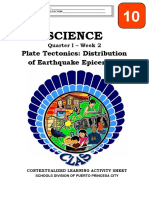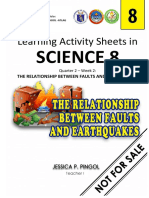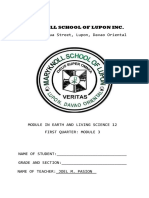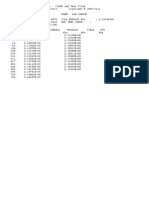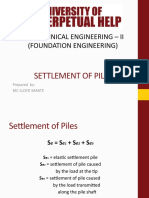Earthquake and Faults
Earthquake and Faults
Uploaded by
Ellie Pama PastranaCopyright:
Available Formats
Earthquake and Faults
Earthquake and Faults
Uploaded by
Ellie Pama PastranaOriginal Title
Copyright
Available Formats
Share this document
Did you find this document useful?
Is this content inappropriate?
Copyright:
Available Formats
Earthquake and Faults
Earthquake and Faults
Uploaded by
Ellie Pama PastranaCopyright:
Available Formats
SCIENCE 8 – WORK FROM HOME ACTIVITY
Quarter 2: Week 1: Earthquakes and Faults
PRE -TEST
Directions: Choose the letter of the best answer.
1. How faults are formed?
A. faults formed when significant movements occur.
B. faults forms when rocks of the crust are compressed or stretched by plate movement.
C. a crack or a break on the earth’s crust.
D. fault is fracture or break in Earth’s crust where earthquakes are most likely to occur.
2. Where do most earthquakes occur?
A. along dikes B. along faults C. along folds D. along joints
3. ______ Implies that the rocks are displaced or shifted considerably.
A. Dip movement B. Significant movement C. Fault movement D. Epicenter movement
4. Which statements best describe a fault
A. A break found under the sea. C. A crack or a break on the earth’s crust.
B. A break line in the interior of the earth. D. A break found on both surface and interior part
5.It is the point of origin of an earthquake.
A. Epicenter B. Focus C. Fault line D. Fault plane
EARTHQUAKES AND FAULTS
An earthquake is caused by a sudden slip on a fault. The tectonic plates are always slowly moving, but they get stuck at their
edges due to friction. When the stress on the edge overcomes the friction, there is an earthquake that releases in the form of energy
in waves that travel through the earth's interior and crust that cause the shaking that we feel.
A fault is a fracture or zone of fractures between two blocks of rock. Faults allow the blocks to move relative to each other.
This movement may occur rapidly, in the form of an earthquake or may occur slowly, in the form of creep. Faults may range in length
from a few millimeters to thousands of kilometers. Most faults produce repeated displacements over geologic time.
How do faults produce quakes? Energy from Earth’s interior makes the ground move. Friction hold the rocks together. Once
the friction is overcome, the ground will move and the earthquake will occur. Earthquakes are caused when faults slip suddenly.
Friction between the two sides of a fault keeps it from moving until the stress on the fault overcomes the friction, then the fault slips
and creates an earthquake.
Types of Faults
1. Normal Fault A dip – slip fault in which the block above the fault has moved downward relative to the block below. This type of
faulting occurs in response to extension. “Occurs when the “hanging wall” moves down relative to the “footwall”
2. Reverse Fault A dip –slip fault in which the upper block, above the fault plane, moves up and over the lower block. This type of
faulting is common in areas of compression. When the dip angle is shallow, a reverse fault is often described as a thrust fault.
“Occurs where the”hanging wall” moves up or thrust over the “foot wall”.
3. Strike-slip Fault A fault on which the two blocks slide past one another or the movement of the block is purely horizontal. There
are two types of strike –slip fault movement. Imagine yourself standing on one side of a strike-slip fault. If the block on the other
side is displaced to your right, the fault is a right lateral strike-slip fault. If the block on the other side of the fault is displaced to
your left, the fault is a left lateral strike-slip fault.
Activity 1: Graphic Organizer
Complete the Concept Map
mayjoyortizopaborada
You might also like
- Lab 5 Tensile Testing of Metal and PolymerDocument7 pagesLab 5 Tensile Testing of Metal and Polymerjacob liberatoreNo ratings yet
- Science 10 First Quarter ModuleDocument11 pagesScience 10 First Quarter ModuleAnngela Arevalo Barcenas100% (6)
- Faults and Earthquakes2Document60 pagesFaults and Earthquakes2lanceramirez801No ratings yet
- Science8 Q2 Wk1 Earthquakes-And-Faults - LrqaDocument13 pagesScience8 Q2 Wk1 Earthquakes-And-Faults - LrqaMELISSA PASCUALNo ratings yet
- G8 Q2 Week 1 1Document68 pagesG8 Q2 Week 1 1nutssdeez944No ratings yet
- Q2 M1 Earthquakes-and-FaultsDocument74 pagesQ2 M1 Earthquakes-and-FaultsMariel BalistaNo ratings yet
- Earth and Life Science: Earth 'S Geological ProcessesDocument8 pagesEarth and Life Science: Earth 'S Geological ProcessesGentila LancheNo ratings yet
- Q2 M1 Earthquake and FaultsDocument96 pagesQ2 M1 Earthquake and Faultsacethryxie25ortegaNo ratings yet
- Activity 1 - Faults and EarthquakesDocument10 pagesActivity 1 - Faults and EarthquakesCharo Nudo Pongasi100% (1)
- 2nd QUARTER SCIENCE COMPENDIUM G8Document42 pages2nd QUARTER SCIENCE COMPENDIUM G8kreiosromolusNo ratings yet
- Science6 Q4 Mod1 ChangesontheSurfaceoftheEarthDocument16 pagesScience6 Q4 Mod1 ChangesontheSurfaceoftheEarthJean Angelie Larombe NadaNo ratings yet
- Module 2Q SCI 8 1Document23 pagesModule 2Q SCI 8 1PeterClomaJr.No ratings yet
- Earth Science Q2 Week3Document10 pagesEarth Science Q2 Week3MCAPUZ, MARK JOHN, V.No ratings yet
- 2nd - Science-Second-Quarter-Week-1Document37 pages2nd - Science-Second-Quarter-Week-1Arlene AranzasoNo ratings yet
- Q 2 Sci 8 WK 1Document3 pagesQ 2 Sci 8 WK 1Janice MukodNo ratings yet
- Science8 Q2 Week 1Document15 pagesScience8 Q2 Week 1Eye Ris LadromaNo ratings yet
- Q2 - M1 - Earthquake and FaultsDocument106 pagesQ2 - M1 - Earthquake and FaultsDaniel ManuelNo ratings yet
- Science8 - Q2 - EarthquakesAnd Faults - V1Document19 pagesScience8 - Q2 - EarthquakesAnd Faults - V1QUEENIE JAM ABENOJANo ratings yet
- Q2 Science8 Las W1Document15 pagesQ2 Science8 Las W1Ronna Jean SambitanNo ratings yet
- Pingol, Jessica - LAS Q2 W4 Earthquakes (Focus, Epicenter, Magnitude and Intensity) in Active and Inactive FaultsDocument7 pagesPingol, Jessica - LAS Q2 W4 Earthquakes (Focus, Epicenter, Magnitude and Intensity) in Active and Inactive FaultsjhzcartNo ratings yet
- EL M/ Week 5 6Document20 pagesEL M/ Week 5 6Mariels FernandezNo ratings yet
- Module 6 Lesson 2Document9 pagesModule 6 Lesson 2Althea Kaith FernandezNo ratings yet
- Lesson 2.1 - FaultDocument3 pagesLesson 2.1 - FaultMoses TenoriaNo ratings yet
- LP4 w4 Earth and Life ScienceDocument7 pagesLP4 w4 Earth and Life ScienceJiego PabiaNo ratings yet
- Science10 q1 CLAS2 Plate Tectonics Distribution of Earthquake Epicenters V4-Converted (1) - RHEA ANN NAVILLADocument13 pagesScience10 q1 CLAS2 Plate Tectonics Distribution of Earthquake Epicenters V4-Converted (1) - RHEA ANN NAVILLASophia Erika LargoNo ratings yet
- Scienceskwela Tacradio Broad ScriptDocument8 pagesScienceskwela Tacradio Broad ScriptDhanessa CondesNo ratings yet
- Pingol, Jessica - LAS Q2 W1 EARTHQUAKES AND FAULTSDocument8 pagesPingol, Jessica - LAS Q2 W1 EARTHQUAKES AND FAULTSjhzcartNo ratings yet
- Science 1st Quarter Grade 8 ReferenceDocument23 pagesScience 1st Quarter Grade 8 ReferencedanakylynNo ratings yet
- Earthquake Faults: It's A SnapDocument4 pagesEarthquake Faults: It's A SnapKim SmithNo ratings yet
- SCIENCE Module Quarter 2 Week 1Document5 pagesSCIENCE Module Quarter 2 Week 1MACAINAG, AngelicaNo ratings yet
- Laboratory 8: Faults, Folds, and Cross-Cutting RelationshipsDocument8 pagesLaboratory 8: Faults, Folds, and Cross-Cutting RelationshipsXuan PhuongNo ratings yet
- Week 4 MovementOfPlates - lukeFLORDocument9 pagesWeek 4 MovementOfPlates - lukeFLORCheena Francesca LucianoNo ratings yet
- Earthquakes-and-FaultsDocument62 pagesEarthquakes-and-Faultsnacariorenz88No ratings yet
- Maryknoll School of Lupon Inc.: Kambing Baratua Street, Lupon, Davao OrientalDocument23 pagesMaryknoll School of Lupon Inc.: Kambing Baratua Street, Lupon, Davao OrientalJoshua James Sanguenza RodriguezNo ratings yet
- Earthquake Faults FinalDocument68 pagesEarthquake Faults Finalkishnikamarielozano13No ratings yet
- Earthquakes and FaultsDocument14 pagesEarthquakes and FaultsBEALYN OLANNo ratings yet
- Earth Science: 2 Grading Grade 8 "Remediation"Document11 pagesEarth Science: 2 Grading Grade 8 "Remediation"Shane Catherine BesaresNo ratings yet
- Eathquake and FaultsDocument5 pagesEathquake and FaultsRowena DivinoNo ratings yet
- Earthquake and Faults-EditedDocument67 pagesEarthquake and Faults-EditedJayson Attaban100% (1)
- TYPES-OF-PLATE-BOUNDARIES-Earths-MechanismDocument53 pagesTYPES-OF-PLATE-BOUNDARIES-Earths-Mechanismluvsheyn11No ratings yet
- For Demo Teaching EarthquakesDocument83 pagesFor Demo Teaching EarthquakesMHadzNo ratings yet
- Science-8_Lesson-1_Earthquakes-and-FaultsDocument33 pagesScience-8_Lesson-1_Earthquakes-and-FaultsoccianoshaunandreiNo ratings yet
- Earthquake - Layers of The EarthDocument36 pagesEarthquake - Layers of The EarthdczarinasantosNo ratings yet
- Mapeh 9 ReviewerDocument32 pagesMapeh 9 ReviewerLaiza Nicole DoletinNo ratings yet
- LAS SCIE8 Q2 Week1 4Document14 pagesLAS SCIE8 Q2 Week1 4Edie Lyn CatapangNo ratings yet
- Earthquakes and Faults InformationDocument1 pageEarthquakes and Faults InformationReina BenguaNo ratings yet
- Faults: Department of EducationDocument12 pagesFaults: Department of Educationnikki romuloNo ratings yet
- QUARTER 2 LESSON 2 Earthquake's Epicenter, Focus, Magnitude, Intensity, Active and Inactive FaultsDocument13 pagesQUARTER 2 LESSON 2 Earthquake's Epicenter, Focus, Magnitude, Intensity, Active and Inactive FaultsJose BundalianNo ratings yet
- Earthquakes and FaultsDocument35 pagesEarthquakes and FaultsLeahNo ratings yet
- Science8 Quarter2 Week1Document8 pagesScience8 Quarter2 Week1Nicolette ColesNo ratings yet
- Chapter 10: Geological Structure: A Recumbent Fold - A Fold Lying Down Results From The Continuation ofDocument56 pagesChapter 10: Geological Structure: A Recumbent Fold - A Fold Lying Down Results From The Continuation ofMuhammad Wahyu SaputroNo ratings yet
- EARTHQUAKES AND FAULTS - What Is FaultDocument12 pagesEARTHQUAKES AND FAULTS - What Is Faultbonnie rickNo ratings yet
- Earth and Life Science Week 5Document10 pagesEarth and Life Science Week 5Shy SubijanoNo ratings yet
- G8 Science Q2 - Week1 - EarthquakeDocument61 pagesG8 Science Q2 - Week1 - EarthquakeIemmee Jane DinglasanNo ratings yet
- Science g8 q2 Module 1 WK 1Document26 pagesScience g8 q2 Module 1 WK 1Arlene PajaresNo ratings yet
- S8 - Q2 - Week 1Document11 pagesS8 - Q2 - Week 1Dabe Genesis Ligalig100% (1)
- Science Q2 Weeks1to4Document41 pagesScience Q2 Weeks1to4maeyonnaise127No ratings yet
- Disaster Risk Reduction and ManagementDocument3 pagesDisaster Risk Reduction and ManagementMedija FamilyNo ratings yet
- Week 1Document6 pagesWeek 1Christine CayosaNo ratings yet
- The Ground Is Shaking! What Happens During An Earthquake? Geology for Beginners| Children's Geology BooksFrom EverandThe Ground Is Shaking! What Happens During An Earthquake? Geology for Beginners| Children's Geology BooksNo ratings yet
- Shake, Rattle, and Roll: Exploring the Science of EarthquakesFrom EverandShake, Rattle, and Roll: Exploring the Science of EarthquakesNo ratings yet
- Mud Volcano with Vinegar and Baking SodaDocument3 pagesMud Volcano with Vinegar and Baking SodaEllie Pama PastranaNo ratings yet
- Grade 9- DLL Q3Document83 pagesGrade 9- DLL Q3Ellie Pama PastranaNo ratings yet
- Q2W1ACTIVITYDocument2 pagesQ2W1ACTIVITYEllie Pama PastranaNo ratings yet
- Methods of Separating MixturesDocument2 pagesMethods of Separating MixturesEllie Pama PastranaNo ratings yet
- DAILY LESSON PLAN Science 8Document5 pagesDAILY LESSON PLAN Science 8Ellie Pama PastranaNo ratings yet
- Sci8 - Q4 - M7 - Human Activities and The EnvironmentDocument21 pagesSci8 - Q4 - M7 - Human Activities and The EnvironmentEllie Pama PastranaNo ratings yet
- Work and EnergyDocument31 pagesWork and EnergyEllie Pama PastranaNo ratings yet
- Newtons Three Laws of MotionDocument39 pagesNewtons Three Laws of MotionEllie Pama PastranaNo ratings yet
- Grade 7 10 - Araling PanlipunanDocument15 pagesGrade 7 10 - Araling PanlipunanEllie Pama PastranaNo ratings yet
- Heat and TemperatureDocument63 pagesHeat and TemperatureEllie Pama PastranaNo ratings yet
- Emergency Survival KitDocument1 pageEmergency Survival KitEllie Pama PastranaNo ratings yet
- CINH 01cgDocument3 pagesCINH 01cgWindy MartdianzahNo ratings yet
- Compression Testing of Metallic Materials at Room TemperatureDocument10 pagesCompression Testing of Metallic Materials at Room TemperatureSandipGangurdeNo ratings yet
- UntitledDocument1,400 pagesUntitledSrisaran Srinivas ArasavelliNo ratings yet
- Tribology in Industry: C. Fragassa, N. Radovic, A. Pavlovic, G. MinakDocument12 pagesTribology in Industry: C. Fragassa, N. Radovic, A. Pavlovic, G. MinakenjpetNo ratings yet
- CH 7 Dislocations and Strengthening Mechanisms 1Document74 pagesCH 7 Dislocations and Strengthening Mechanisms 1Nasser SA100% (1)
- TEnsion MembersDocument24 pagesTEnsion MembersJade CarilloNo ratings yet
- Figure-Prestressing of Concrete Beams by Mild Steel RodsDocument4 pagesFigure-Prestressing of Concrete Beams by Mild Steel RodsJaneeshVargheseNo ratings yet
- Safe Design ReportDocument25 pagesSafe Design ReportTesCospNo ratings yet
- Stress Strain Curve For Mild Steel - The Chicago CurveDocument3 pagesStress Strain Curve For Mild Steel - The Chicago CurveNoor AzlanNo ratings yet
- Lecture 6Document14 pagesLecture 6Joe AllanNo ratings yet
- Lecture4 3-d Stress Tensor and Equilibrium EquationsDocument18 pagesLecture4 3-d Stress Tensor and Equilibrium Equationssamurai7_77No ratings yet
- State of Practice - Micropile Structural and Geotechnical DesignDocument123 pagesState of Practice - Micropile Structural and Geotechnical DesignJonathan Bennett PE DGE100% (5)
- Pad Footing 200X350 COLDocument6 pagesPad Footing 200X350 COLAkela RichardNo ratings yet
- Fatigue Stress - NomenDocument9 pagesFatigue Stress - NomenParth AuradkarNo ratings yet
- Design Cal For Rigid PavementDocument6 pagesDesign Cal For Rigid Pavementrachana100% (1)
- Failure Theories For Brittle MaterialsDocument47 pagesFailure Theories For Brittle MaterialsFaraz AhmedNo ratings yet
- Tensile Test Lab ReportDocument13 pagesTensile Test Lab Reportahmad adnanNo ratings yet
- Design of Compression Members: As Per IS 800: 2007Document119 pagesDesign of Compression Members: As Per IS 800: 2007umeshapkNo ratings yet
- Geotechnical Engineering - Ii (Foundation Engineering) : Settlement of PilesDocument11 pagesGeotechnical Engineering - Ii (Foundation Engineering) : Settlement of PilesPascasio PascasioNo ratings yet
- How To Analyze Gear FailuresDocument7 pagesHow To Analyze Gear Failuresphucdc095041No ratings yet
- An Analysis of Composite Drive Shaft Using Ansys AcpDocument8 pagesAn Analysis of Composite Drive Shaft Using Ansys AcpTJPRC PublicationsNo ratings yet
- Required RC Jacket Thickness and Reinforcement Ratio For Repairing RC Tied Rectangular and Circular Concrete ColumnsDocument14 pagesRequired RC Jacket Thickness and Reinforcement Ratio For Repairing RC Tied Rectangular and Circular Concrete ColumnsSengpaseuth KeobounnamNo ratings yet
- Lecture 2.b.1 Analysis of RC Beams-Ultimate Strength StageDocument16 pagesLecture 2.b.1 Analysis of RC Beams-Ultimate Strength StageAdrian MonteclaroNo ratings yet
- AMS Unsymmetrical BendingDocument20 pagesAMS Unsymmetrical Bendingbiranchi100% (1)
- Effect of Soil Characteristics On RelatiDocument14 pagesEffect of Soil Characteristics On RelatiNicolas MontecinosNo ratings yet
- The Relation Between Liquefaction Resistance and Shear Wave Velocity For New and Old DepositsDocument14 pagesThe Relation Between Liquefaction Resistance and Shear Wave Velocity For New and Old DepositsmakiNo ratings yet
- 4-Thick Cylinders-TutDocument2 pages4-Thick Cylinders-TutMohdYasir100% (1)
- Structural Notes PDFDocument158 pagesStructural Notes PDFAin ZulkefliNo ratings yet
























